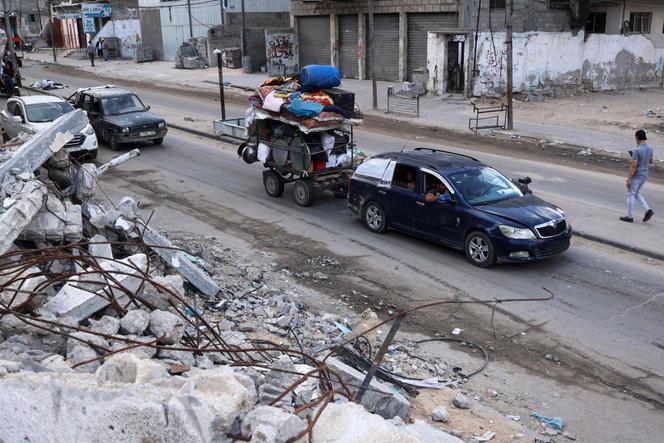Israeli attacks force 60 desalination plants to shutter in Gaza – The New Arab

Report on the Water Crisis in Gaza and its Contravention of Sustainable Development Goals
Executive Summary
Sustained bombardment in the Gaza Strip has resulted in a severe humanitarian crisis, characterized by the systematic destruction of essential water infrastructure. This report details the impact of the conflict on the availability of clean water and sanitation, directly undermining several United Nations Sustainable Development Goals (SDGs), most notably SDG 6 (Clean Water and Sanitation) and SDG 3 (Good Health and Well-being). Information provided by international aid organizations indicates a deliberate deprivation of necessities, leading to widespread disease and exacerbating famine conditions, further impacting SDG 2 (Zero Hunger) and SDG 11 (Sustainable Cities and Communities).
Severe Setbacks to SDG 6: Clean Water and Sanitation
Access to clean water and sanitation, the core of SDG 6, has been critically compromised. The destruction and obstruction of water infrastructure have left the population with insufficient levels of clean water.
- At least 60 desalination plants have been destroyed.
- Two of the three primary water pipelines into Gaza have been repeatedly damaged since October 2023.
- An estimated 70 percent of water flowing through these pipelines is lost due to leaks caused by bombing damage.
Efforts to restore these essential services have been actively hindered, further violating the principles of SDG 6.
- Israel is reportedly preventing the import of materials necessary for water treatment. Médecins Sans Frontières (MSF) has received only one approval for every ten requests to import desalination materials since June 2024.
- The repair of damaged water systems has been prevented.
- Forced displacement orders issued by the Israeli army, affecting approximately 86 percent of the Gaza Strip, have prevented safe access for water trucks.
Detrimental Impact on SDG 3: Good Health and Well-being
The collapse of water infrastructure has led to a public health catastrophe, directly contravening the objectives of SDG 3. The lack of clean water for drinking and hygiene has resulted in a significant increase in waterborne and skin diseases.
- MSF medical teams have conducted over 1,000 consultations per week in the last month for patients suffering from acute diarrhea.
- A lack of sufficient water for hygiene has led to the spread of skin diseases such as scabies.
- The crisis is compounded by extensive damage to the healthcare infrastructure itself.
Compounding Effects on Other Sustainable Development Goals
The water crisis has a cascading effect on other critical SDGs, highlighting the interconnectedness of development, humanitarian aid, and peace.
- SDG 2 (Zero Hunger): The weaponization of water, as described by Oxfam, directly contributes to famine conditions by crippling food production and making safe food preparation impossible.
- SDG 11 (Sustainable Cities and Communities): The destruction of essential infrastructure makes communities uninhabitable and unsustainable, leading to mass forced displacement.
- SDG 16 (Peace, Justice and Strong Institutions): Reports from MSF and Oxfam suggest an intentional disruption of humanitarian efforts and the deliberate deprivation of necessities, actions that undermine peace and justice.
Humanitarian Consequences
The civilian population bears the brunt of the infrastructure collapse, facing daily hardships that put their lives at risk.
- Civilians, including children, are forced to walk for miles to find water, often carrying heavy jerry cans amidst active bombardment.
- MSF reports that children frequently get lost when searching for water after distribution sites are forced to move due to airstrikes or displacement orders.
- Prior to the war, Gaza already faced water challenges due to salinity and contamination, making the reliance on and subsequent destruction of piped infrastructure even more critical.
SDGs Addressed in the Article
-
SDG 6: Clean Water and Sanitation
The article’s central theme is the severe water crisis in Gaza. It extensively details the destruction of water infrastructure, the lack of access to clean water, and the contamination issues, directly aligning with the core objectives of SDG 6.
-
SDG 3: Good Health and Well-being
The text explicitly links the water shortage to severe health consequences. It reports on the spread of water-borne diseases like acute diarrhoea and skin conditions such as scabies, which are direct threats to the health and well-being of the population, a key concern of SDG 3.
-
SDG 11: Sustainable Cities and Communities
The article highlights the widespread destruction of “essential infrastructure,” including desalination plants and water pipelines. This destruction, coupled with the forced displacement of “around 86 percent of the Gaza Strip,” undermines the goal of making human settlements safe, resilient, and sustainable as outlined in SDG 11.
-
SDG 16: Peace, Justice and Strong Institutions
The context of the article is a military conflict, described as “Sustained Israeli bombardment.” It discusses actions such as the “deliberate depriving Palestinians of necessities,” preventing the repair of damaged systems, and the “intentional disruption of humanitarian efforts.” These points relate directly to the breakdown of peace and justice, which SDG 16 aims to address.
Specific SDG Targets Identified
-
SDG 6: Clean Water and Sanitation
-
Target 6.1: Achieve universal and equitable access to safe and affordable drinking water for all.
The article demonstrates a complete failure to meet this target. It states that “clean water [is] hard to come by for civilians,” “the amount of clean water levels available in Gaza is now completely insufficient,” and civilians are “forced to walk miles… to find water.” This shows a lack of universal and equitable access.
-
Target 6.a: Expand international cooperation and capacity-building support… in water- and sanitation-related activities and programmes, including… desalination.
The article highlights the opposite of this target. Instead of cooperation, it notes that “Israel is preventing the import of materials necessary for water treatment” and that aid group MSF “has received only one approval for every ten requests to import materials for desalination.” This represents a direct obstruction of international support for water-related activities.
-
-
SDG 3: Good Health and Well-being
-
Target 3.3: End the epidemics of… water-borne diseases and other communicable diseases.
This target is directly relevant as the article reports a surge in diseases due to the lack of clean water. MSF’s medical teams have conducted “over 1,000 consultations per week… for patients… suffering from acute diarrhoea.” Furthermore, the lack of water for hygiene has led to the development of “skin diseases such as scabies,” indicating a failure to control communicable and water-borne diseases.
-
-
SDG 11: Sustainable Cities and Communities
-
Target 11.5: Significantly reduce the number of deaths and the number of people affected… caused by disasters, including water-related disasters, with a focus on protecting the poor and people in vulnerable situations.
The ongoing bombardment is a man-made disaster that has destroyed critical water infrastructure, directly affecting the entire population. The article states that “at least 60 desalination plants” have been destroyed and “two out of three water pipelines” have been damaged, leading to a water crisis that disproportionately affects a vulnerable, displaced population.
-
-
SDG 16: Peace, Justice and Strong Institutions
-
Target 16.1: Significantly reduce all forms of violence and related death rates everywhere.
The article is framed by the context of ongoing violence, described as “Sustained Israeli bombardment” and “22 months of war.” The destruction and humanitarian crisis are direct consequences of this violence, making this target highly relevant.
-
Indicators for Measuring Progress
-
SDG 6: Clean Water and Sanitation
-
For Target 6.1 (Access to Water):
The article provides several quantifiable and qualitative indicators:
- Number of functional water facilities: The destruction of “at least 60 desalination plants” serves as a direct indicator of diminished capacity.
- Integrity of water distribution network: The damage to “two out of three water pipelines” and the loss of “an estimated 70 percent of the water flowing through these pipelines… due to leaks” are clear metrics of network failure.
- Population with access to safe water: The statement that “Most of the civilians in Gaza have lost access to clean water” implies an indicator measuring the proportion of the population without access.
-
For Target 6.a (International Cooperation):
An indicator is explicitly mentioned:
- Rate of approval for humanitarian imports: The fact that MSF “has received only one approval for every ten requests to import materials for desalination” is a specific indicator measuring the level of obstruction to international aid and cooperation.
-
-
SDG 3: Good Health and Well-being
-
For Target 3.3 (End Epidemics):
The article provides health-related data that can be used as indicators:
- Incidence of water-borne diseases: The report of “over 1,000 consultations per week… for patients… suffering from acute diarrhoea” is a direct indicator of the prevalence of such diseases.
- Prevalence of hygiene-related diseases: The mention that “people have also developed skin diseases such as scabies” serves as a qualitative indicator of public health decline due to poor sanitation.
-
-
SDG 11: Sustainable Cities and Communities
-
For Target 11.5 (Disaster Impact):
The article implies indicators related to disaster impact:
- Proportion of population displaced: The figure that “around 86 percent of the Gaza Strip has been subjected to forced displacement orders” is a direct indicator of the scale of population disruption.
- Damage to critical infrastructure: The destruction of 60 desalination plants and damage to water pipelines are metrics for assessing the impact on essential services.
-
Summary Table of SDGs, Targets, and Indicators
| SDGs | Targets | Indicators |
|---|---|---|
| SDG 6: Clean Water and Sanitation | 6.1: Achieve universal and equitable access to safe and affordable drinking water for all. |
|
| SDG 6: Clean Water and Sanitation | 6.a: Expand international cooperation and capacity-building support… in water- and sanitation-related activities. |
|
| SDG 3: Good Health and Well-being | 3.3: End the epidemics of… water-borne diseases and other communicable diseases. |
|
| SDG 11: Sustainable Cities and Communities | 11.5: Significantly reduce the number of people affected… caused by disasters… with a focus on protecting… vulnerable situations. |
|
| SDG 16: Peace, Justice and Strong Institutions | 16.1: Significantly reduce all forms of violence and related death rates everywhere. |
|
Source: newarab.com

What is Your Reaction?
 Like
0
Like
0
 Dislike
0
Dislike
0
 Love
0
Love
0
 Funny
0
Funny
0
 Angry
0
Angry
0
 Sad
0
Sad
0
 Wow
0
Wow
0



















































.jpg.webp?itok=0ZsAnae9#)
























